A Life Journey: Interview 9
- Nov 16, 2018
- By Stephen Cole
- In Interviews
Conducted February 18th, 2011
Karen talks about a series of selected artefacts from her early life and career
This (Figure 1) is a dress that was made one of the winter afternoons that we sat round the dining room table. One of the maids did the embroidery and my aunt made it into a dress. I’m not sure if it’s on the photograph you were talking about before. Pretty. (Holds it up against herself) too small (laughs).
Can you remember wearing it, Karen?
No it wasn’t made for me, it was made for my sister who would have been four at the time… I don’t know, perhaps it was made for me. I mean Grethe was always very little and this is not… this is really for a fat child (laughs).
So you don’t remember wearing it? Do you want to tell us about those afternoons of needlework with the maids and your family?
I think that one of them taught me to knit. And it was a neighbour that taught me to crochet and one of my cousins who taught me to do bobbin lace, ah that was nice, I liked the bobbin lace, and then… I still have the lace board that I used and I don’t know where it is now, probably up in the loft. But I always want to do it to make some more, but at least that’s something you can do even if you’ve got funny hands.
So you’re still able to do that now, if you wanted to?
Because of course you only need dexterity for pushing the pin in the loops. You don’t need it to do the bobbins, so anybody can do bobbin lace (laughs), as indeed is proved I suppose by all the areas where bobbin lace was made for export.
Is there anything else you would like to say about this dress or the embroidery on it?
No, I don’t know if it’s in the photograph I showed you earlier. Perhaps it is. And that led on to all the other things.
Let’s move on to the next one then.
Yes. My mother bought this (Figure 2) for me to embroider and that’s why it came fully finished with Russian bobbin lace. But it was designed for working with stem stitch and I did that, as you can see, not expertly but I quite enjoyed that. I remember that. And you may want to know what the piece is for? It’s something that maybe isn’t so well known in England as it would have been in Denmark. It’s a cloth for hanging over the towels in the bedroom, which was hanging next to the washing arrangement, I’m not sure what that would be called (laughs). And it went over a rod like this, and underneath the rod there were hooks for hanging the towels – I’ve got one up there. And of course that’s my name before I was married, Karen Møller.
Can you remember how old you were when you made this?
I think I must have been perhaps eight, something like that, no more. I got better.
Still very good for an eight year old. And where would you have made it?
First of all because my mother thought it looked nice. I think it was before I really started looking at design. You can see it’s a bit sentimental. The goose girl.
But you liked it at the time? But did you make it on your own or did you make it with the maids around the table?
No, my mother told me it had to be done like this with stem stitch, so I just began in one corner and continued until I finished it.
How long do you think it took you to do?
Couple of weeks? Because I wasn’t so fast then (laughs).
It’s lovely. So tell us about this piece. [Photo missing – shows an embroidery for dressing table, white on blue]
Whenever my mother went shopping in the nearest town, which was Viborg… did I tell you about it before? It’s a county town – the Viking capital of Denmark and so it’s quite old and all the streets have got saints’ names. In one of these shops she would go to whenever she went in and there were a couple of embroidery shops run by very old ladies who probably only made a precarious living, but all the same, were still there and were selling sometimes very nice things. And my mother saw this, which would suit her toilet table very well, and bought it. It comes with a larger cloth and two more of these small ones, and then she taught me what the stitches were intended to be. I knew what they should look like right away so I got on with it. I think perhaps it’s as good a way as any of introducing little girls to embroidery, except of course it would be nice if she also liked the stuff.
Oh didn’t she like it?
I wasn’t all that keen, no.
Ah you didn’t like it.
But it was nice being part of the party round the table. So I did what I was told (laughs).
Tell us about the party around the table.
Well of course there were the maids. The one I remember best was Mary. She had freckled arms and red hair. Never thought about whether I liked red hair or anything, but I loved Mary so whatever she came like that was alright with me (laughs). Later she married the cow man and they got a farm of their own. So yes I enjoyed those afternoons round the table very much and hearing the stories about what had happened around us. And of course lots and lots was gossip (laughs) but it was still part of our lives. And I was glad to be there.
Can you remember any of the gossip stories of the time, you might have heard around that table?
No, not round the table. But there was one horrible story. You remember that I told you that the pastor looked after the village library at the vicarage and he let me spend as much time as I wanted there, which was a lot (laughs), and on one occasion he forgot that I was there. And the phone in the hall rang and it was someone who wanted to discuss something very very sad with him. I knew that I wasn’t intended to listen but I also didn’t know how to get out (laughs) without being seen and so I stayed. And it was about a neighbour from an outlying farm who had abused his 12, 13 year old daughter and she was pregnant and they were trying to think of how to deal with the situation. I’ll never forget that – I’ve never spoken about it until now (laughs).
That must have been very shocking.
It was. I didn’t know what much of it meant, but I did get the gist of it. I suppose that happens in many communities, only I didn’t know anything. Shall we go on to the next item?
If you feel like it. Thank you for sharing that with us though Karen.
My pride and joy. This (Figure 3) was one of my set pieces at art school and of course it was a set piece because it was a double weave. You don’t think of it like that when you see it, do you, but it was woven as a double weave. So it was like this in the loom. And it was woven by my running the shuttles through on the top layer and then in the back layer and then back again and up. And that meant that when it was finished all you had to do, given that you hadn’t made any mistakes, was open it up and then it was in, this nice table cloth. Of course this was my first attempt, which I hope will excuse the fact that you can tell (laughs). Perhaps if you hold it up to the light you will be able to see through it. Do you want to do that? Reveal the extent of my…
I think we would need to be against the window for that…
Perhaps you can put it in – you can see it can’t you?
You can see through it, yes.
But I was still quite pleased really, except of course to me it shall always be forever faulty (laughs) but we all did a class like that and some of them were worse than mine.
How long did that take to make Karen?
Oh that took a long time. The course was arranged so we could do practical work in the morning and theoretical work in the afternoon. So the time for weaving was of course not very long. But I did enjoy all the practical work. And it taught me an awful lot about materials.
What did it teach you about the materials?
How they work: what’s built into each fibre and what that means in term of making designs that fitted all the various problems.
What kind of thread is it that you used, because this was during the war, wasn’t it?
This was quite good quality cotton, which was of course left over from before the war. Because we were there… I was there from 1943 to ‘46. So all that time we were using what had been left over of the yarns from before the war, so this is pre-war quality. There wasn’t a lot of choice, but most of us managed to make something out of what was there.
And you’ve kept this, since your student days, so this must have meant quite a lot to you.
I gave some of the pieces away but I did keep this, I was very fond of this.
What does it mean to you, this piece?
Well I suppose learning, learning something. Because I think you do have to have handled things in a practical way in order to understand them. And of course I couldn’t have worked in conservation if I hadn’t known how things worked. Because that does come in to the degree in which way wear and tear attacks any fabric and this was what I tried to impart to my students.
So how do you think it has lasted over the years?
Well this has lasted fine, but then it hasn’t been used an awful lot (laughs). Katrina loves it too and she is looking after it too.
Yes it’s lovely.
But there was another tablecloth – that one.
Okay well let’s move onto…
My damask cloth (Figure 4). Yes, well my particular interest was in household textiles and of course a tablecloth is very much part of household textiles. For this we had to use Danish flax, which is not in any way comparable to flax from places like Ireland, or Silesia. Even now after it’s been washed innumerable times I don’t think you can find anything nice to say about the fabric really (laughs). But we still had to do it and I have to say that perhaps it taught us more about the nature of flax than if we had the good material that was used before. I don’t know if you know anything about damask?
I don’t, no.
Well. There are only three weaves. Plain weave, also called tabby; diagonal weave also called [twill]; and then satin weave. And this is satin weave. And for satin weave it’s important that the fabric should become shiny on one side, and I think you can see that it’s shiny on one side and doesn’t reflect light on the other.
Yes it’s more matte.
And that’s what you take advantage of in making the patterns. And that’s how this comes out to have a pattern. You can see the pattern now, and then you’ll know from what we have already said that it’s plain, well rough on one side and shiny on the other.
And how do you make that happen?
Well for that you need five shafts for each, minimum of five shafts for each pattern detail. And this has been designed on 10 shafts so that you can only have two different kinds of pattern detail. And perhaps we should now undo it so (Karen unfolds cloth)… how much can you see of the pattern now?
Ah you can see the closer weave and then it spreads.
Stripes.
Stripes, and that is the more shiny side.
The linen thread that we were forced to use was a bit knobbly and a bit difficult in most respects. In my case that meant that suddenly without me noticing one thread broke, and then as in the nature of weaving, that one thread laid itself across several other threads, and they all broke (laughs). When I threw in the next weft, ah, 23 threads broke. They all had to be repaired before I could continue. That was really really difficult, really hard work. And really really enough to put you off weaving, except it didn’t.
No, obviously not (laughs).
You should be able to find it, but every time it gets washed it gets flatter and less noticeable, now I can’t even find it.
Yes you must have managed it so well, it doesn’t show any more. At the time can you remember how you felt?
Oh, yes I can.
Tell us.
I really can, because this was towards the end of the course and we had to have all these pieces laid out for inspection (laughs), and the people who did the inspection were teachers who came from other weaving courses. And they were not about to let any of us off because we were the most – I don’t know, recommended? – course. And so of course we had to stand up for…
There’d be high standards, yes. So you must have been quite worried that you were going to be exposed.
If I ever find the space again I suppose I could thread and stitch a thread around it. But it was very hard.
You must have felt quite pressured.
Yes. The repairs are done by finding the ones in the warp that haven’t been woven yet and then fastening to the side that has been woven, and then you continue the weaving and you don’t go over the repair until you take it off the loom.
How long to repair it?
Days and days.
As long as that?
I can’t remember exactly how long it was but it wasn’t time that I could spare really (laughs), because there were so many other things that had to be ready.
Did you get any help with that from your tutors or fellow students?
Oh she was very understanding. There was the person in charge of the teaching, Gerda Henning was her name. She herself was a very fine designer, whose work is still shown with pride in the museum. And she was helped by an assistant who really liked young people and looked after us as babies, and helped with everything that she could. She helped with encouragement – she couldn’t do any of the work, she wasn’t allowed to do that, but she encouraged me and she said “it’s not too bad”.
She kept you going?
“You can do it”. That’s what I say to the cat when he’s trying to jump up on the chair (laughs).
So she taught you well, to pass it on.
(Laughs) yes. It didn’t put me off weaving.
No.
Strangely. Definitely not a work of art (Figure 5)…
We won’t talk like that… oh I don’t know, we might do.
Well I worked at the Victoria and Albert Museum from 1954 to ’59. And I shouldn’t say, but do – the scar’s on my shoulders still (laughs). Anyway I did like to work on the technical side of conservation and understand what all the techniques were doing. Until then, I hadn’t done any printing techniques, so when I left the museum I thought I’d have a go at printing. And also learn a little bit about chemistry. And for that I enrolled at Ealing Technical College, but for the printing I enrolled at Hammersmith School of Art. And I learnt this minimum of printing that taught me quite a lot about the difference in technique and what goes into it. This is a very simple technique, and as you can see, my attempt at designing it was equally simple (laughs). It’s not very good.
I don’t know, it’s a nice design.
But it was fun to learn about and I liked being at Hammersmith College of Art for some time.
What made you go out and explore different textile techniques Karen?
I honestly can’t really say because at that stage I was definitely not intending to go on with conservation. I wanted to get back to weaving and design. And that was with absolute certainty. The problem was that the people in the textile department at the V&A didn’t see me like that, so they kept sending nice people with nice interesting objects to me. And I just couldn’t resist. I think perhaps one of the most really really fascinating pieces was what they called ‘Tipu’s Kit’. I don’t know if you know about Tipu?
You did tell us about Tipu in another interview but what might be interesting to talk about is your desire to return to being an artist.
And I’ve shown you the book that I put together about the experiences of Tipu’s Kit?
Ah no you didn’t, no (laughs).
It’s over there, it’s in the green cover.
Maybe we won’t look at it now, but I was interested when you said you wanted to return to being a practising artist and this was an important thing for you to do.
Well it was important in the sense that I wanted to know how it worked. This [tablecloth] is very simple and not of any importance whatsoever but it was part of it.
What did you do after you learnt the printmaking?
I think that was when I started in the chemistry at Ealing College. It was just a short course. But it made it very clear to me that for anybody who was serious about conservation, it was an absolute must.


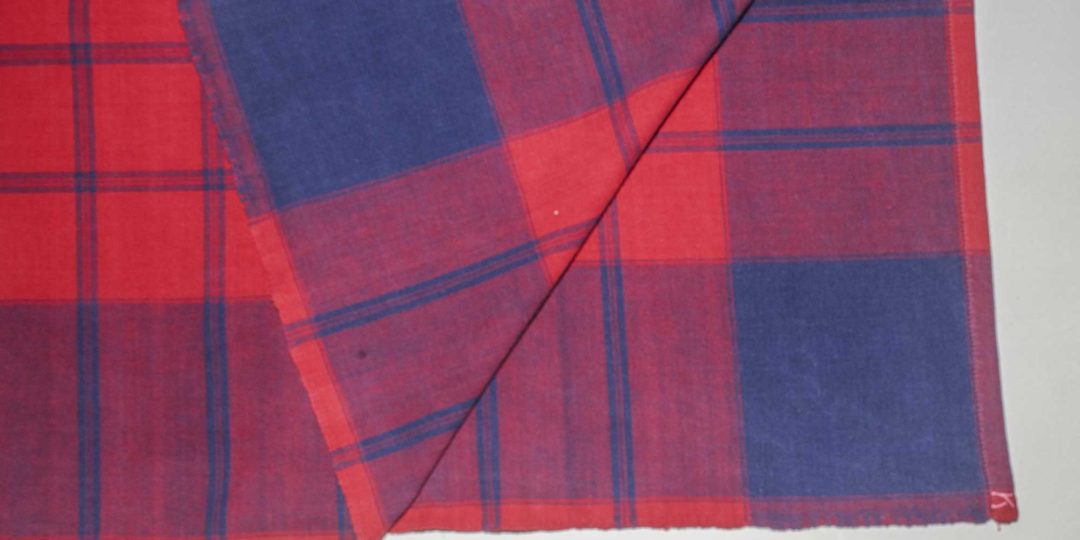
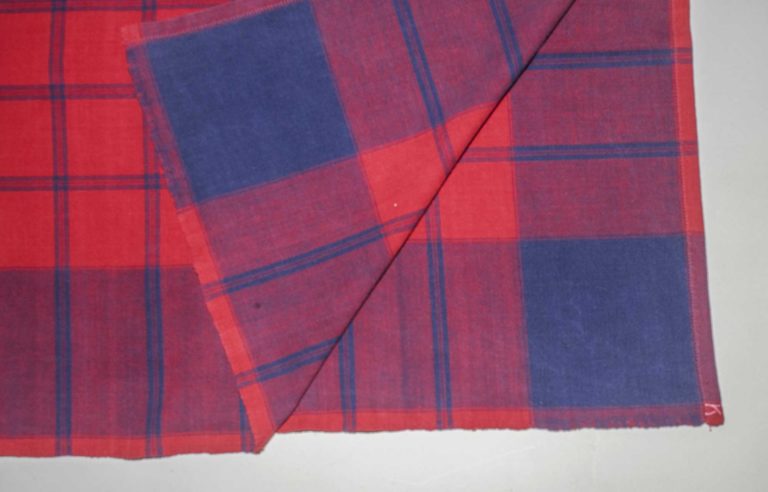

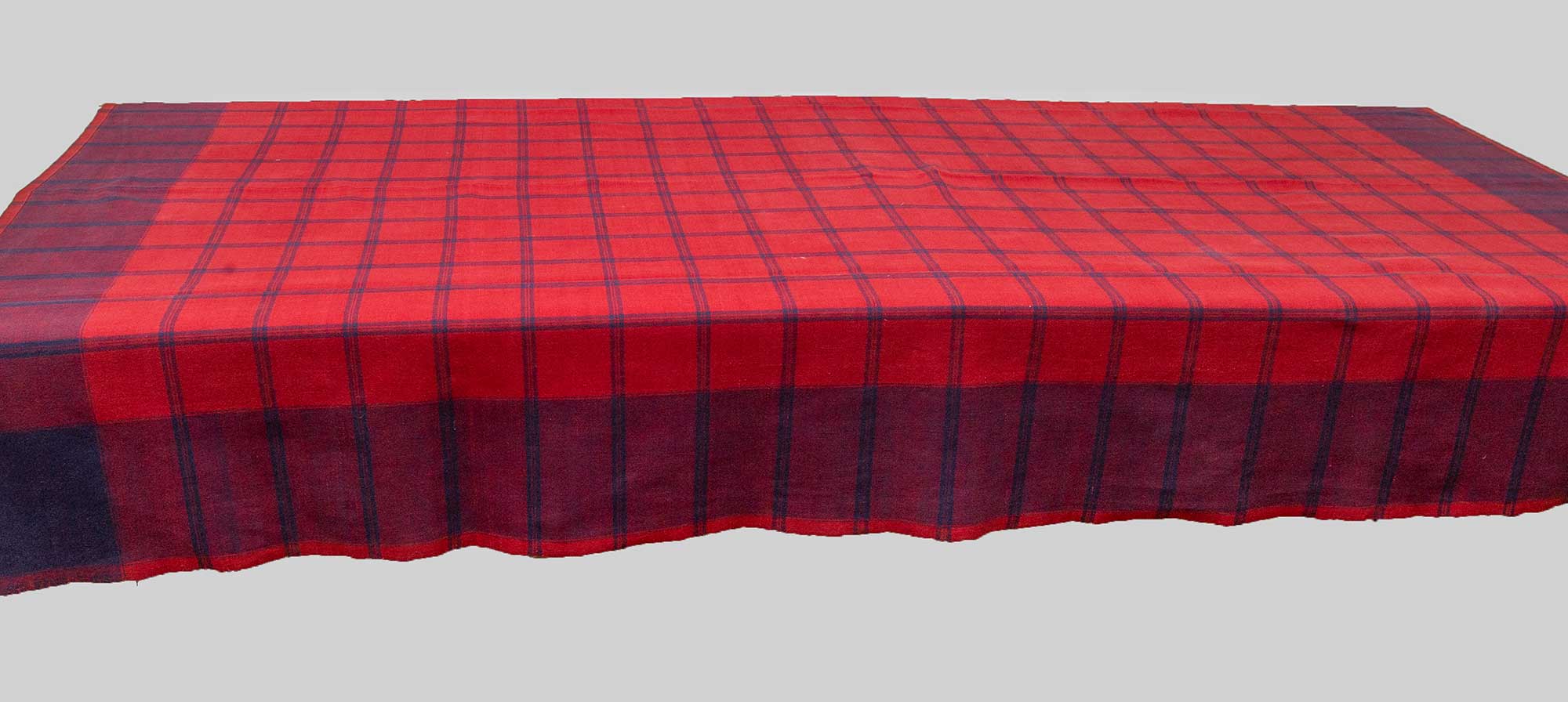
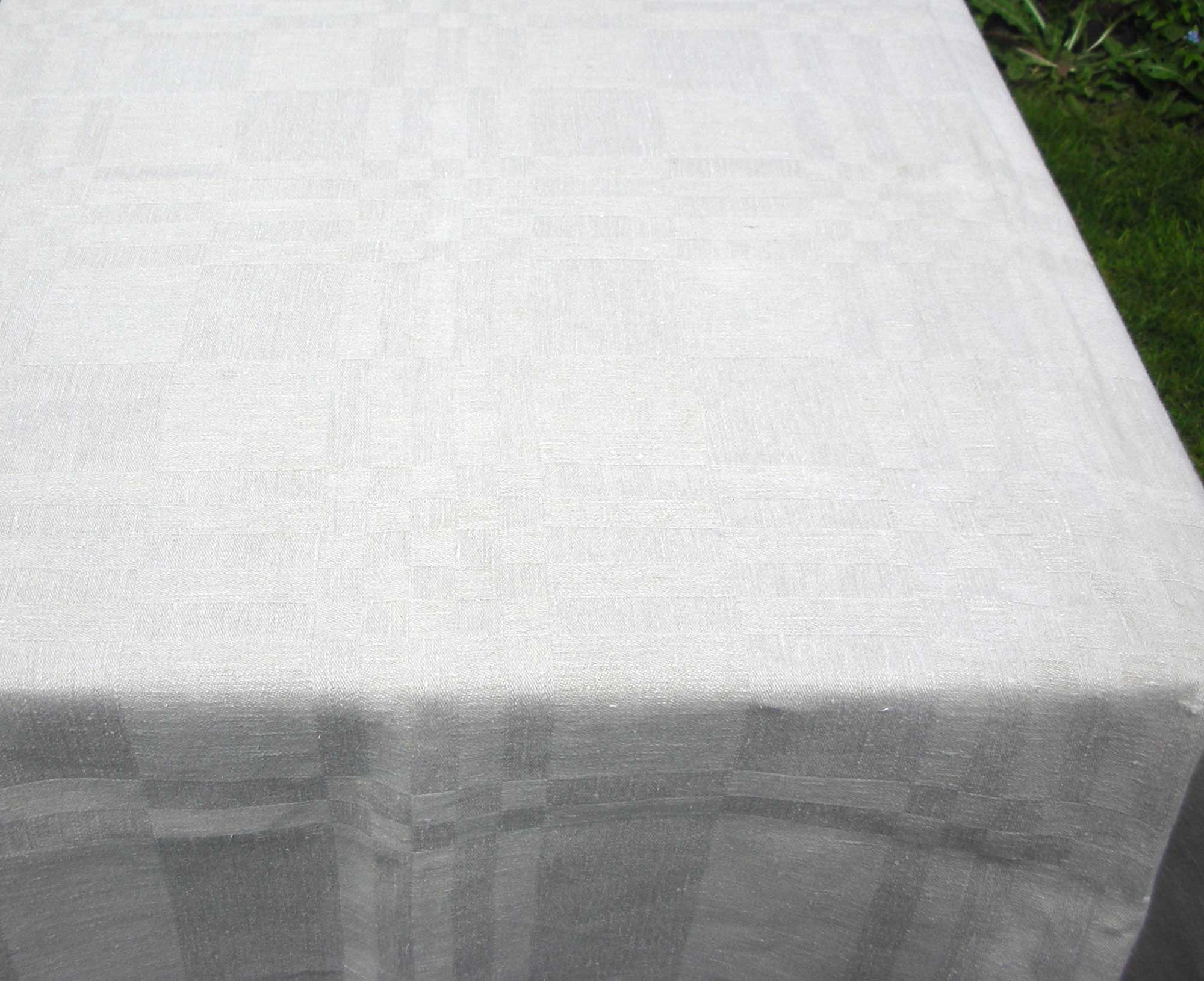
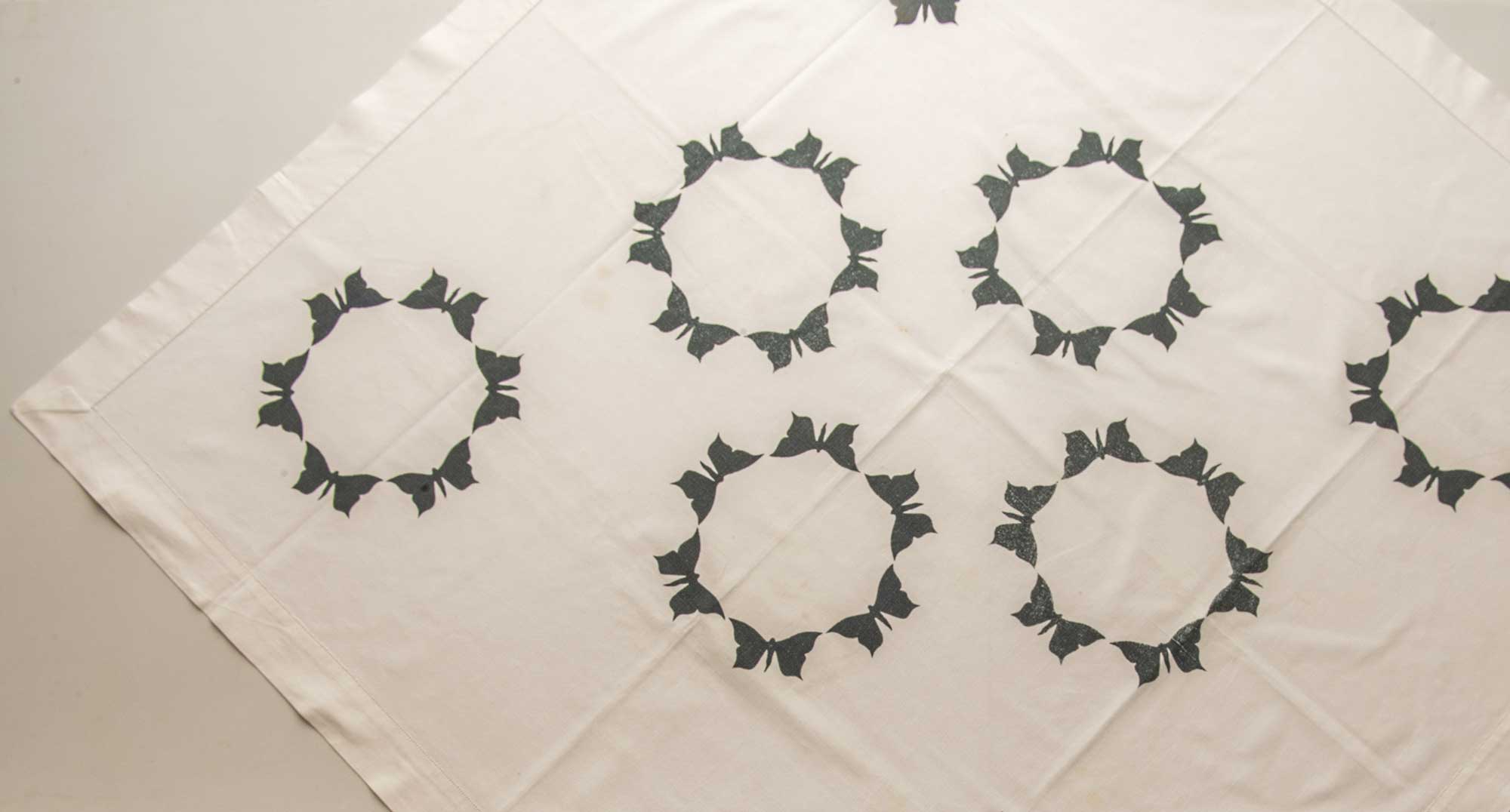
You are not currently logged in. Please log in or register for an account or leave a comment as a guest below.